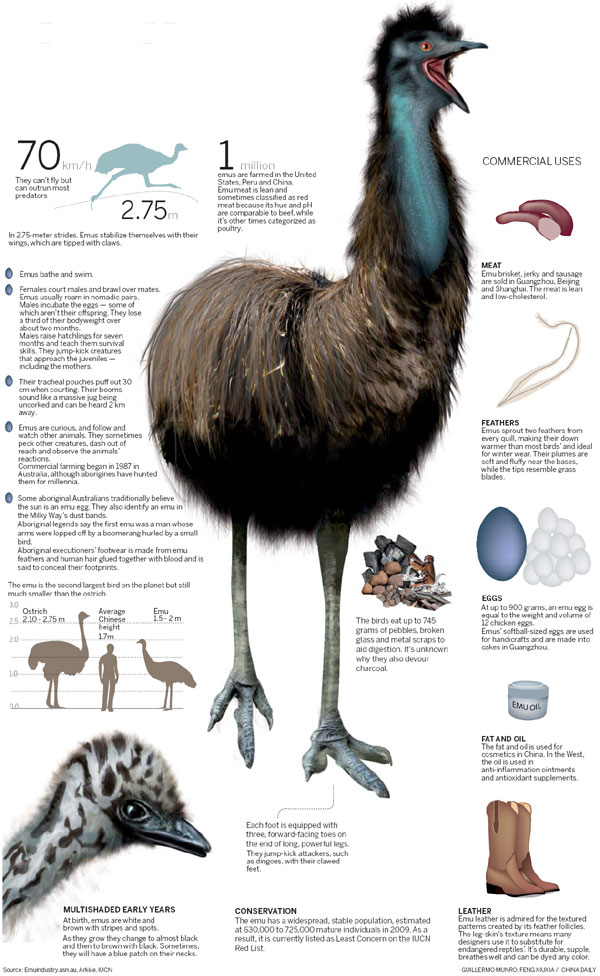Feasible fowl
Updated: 2012-12-05 08:59
By Erik Nilsson (China Daily)
|
|||||||||||

 |
 |
"Apparently, emus can't survive in the wild in Alxa. Actually, many of them that escaped were captured. The others returned to the breeder on their own.
"In the unlikely event of emus having increased by several thousand, it could be considered a festive event that the birds that became extinct hundreds of thousands of years ago have now returned to Eurasia."
Several extinct ratites (large flightless birds) roamed the area millions of years ago, including Struthio wimani, S. mengi, Zhongyuanus xichuanensis and Struthio linxiaensis. The Asian ostrich is believed to have died out just after the most recent ice age and arrival of humans in China, around 10,000 years ago.
Prehistoric Chinese pottery and rock carvings depict ostriches, which some suggest inspired the concept of the phoenix.
Today, Wu cares for Inner Mongolia's reintroduced ratites year-round at OISCA's research institute in Alxa - a lonely compound in the desert outside downtown.
"It's not a bad way to live," he says.
Wulanbatu'er is the only other local to raise emus so far.
The NGO selected the 55-year-old to bring up three of the birds to test the project's viability because he already raises about 600 chickens. These fowl bring in about 20,000 yuan a year for his family of seven.
"I had wondered if these animals are suitable to raise here," he says.
"They are. They're disease-resistant, which makes them better than chickens."
Wulanbatu'er lost about 130 chickens to illness this year.
He can sell his hens for about 40 yuan a kg - less than half the price emu meat fetches.
"I hope to raise more emus," he says. "It's a good deal."
Wulanbatu'er raised sheep until his prairie turned into desert about two decades ago.
"I don't have any grass to feed the sheep," he says.
"So, I turned to chickens. I can buy food for them. Raising poultry is much better, anyway. It's better for the environment. And I don't have to spend all day outside herding them in the freezing wind, especially in winter."
Wulanbatu'er says his family used to grow fruits. It's hard to imagine today that his mash of sand dunes was once lush. He says he lives in a different place than he grew up but never moved out of his house - an earthen dwelling without plumbing, powered by a solar panel.
Alxa's average per-capita income is about 3,000 yuan a year but is much lower among the 60,000 yurt-dwelling Mongolian nomads, who rove throughout the grasslands and deserts. Their earnings have been evaporating, too, as desertification broils the terrain's flora.
Wulanbatu'er believes there are many reasons the Tengali has swallowed his land.
"It's not just overgrazing," he says.
"It's industrialization, pollution and climate change - and probably other causes I don't even know."
But he has hope for the future, he says.
"Raising emus could turn this desert back into the grassland it was most of my life," Wulanbatu'er says.
"Herding sheep is more profitable than raising chickens. But chickens are better for the environment. Emus offer both advantages. They can help us rejuvenate the grasslands and make us more prosperous than ever."
Contact the writer at erik_nilsson@chinadaily.com.cn.
Related Stories
Europe's unwanted guest savored in China 2012-10-16 13:54
Up close with tigers 2012-09-07 14:14
Dinosaur guide launched 2012-12-03 15:50
West Lake Int'l sculpture exhibition opens in Hangzhou 2012-11-28 16:10
White swans on Cuiping Lake in Tianjin 2012-11-29 13:56
Today's Top News
Rescuers race against time for quake victims
Telecom workers restore links
Coal mine blast kills 18 in Jilin
Intl scholarship puts China on the map
More bird flu patients discharged
Gold loses sheen, but still a safe bet
US 'turns blind eye to human rights'
Telecom workers restore links
Hot Topics
Lunar probe , China growth forecasts, Emission rules get tougher, China seen through 'colored lens', International board,
Editor's Picks

|

|

|

|

|

|





